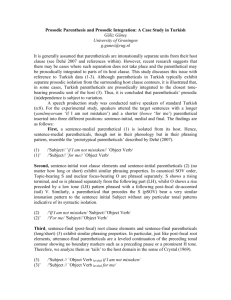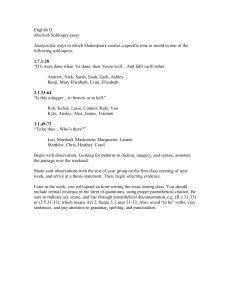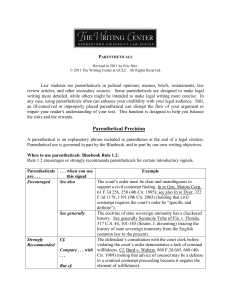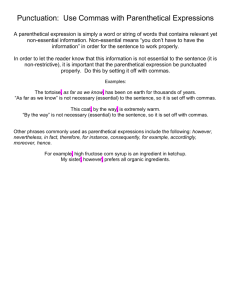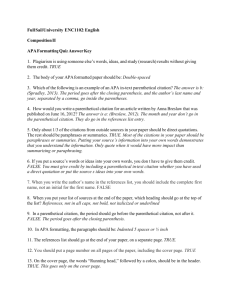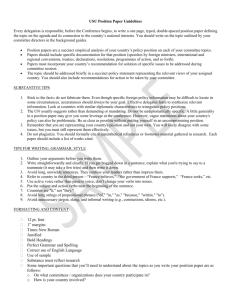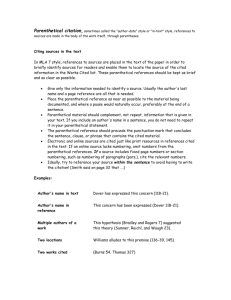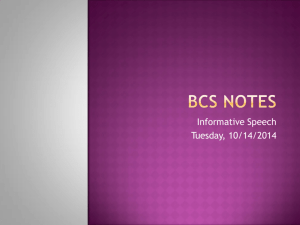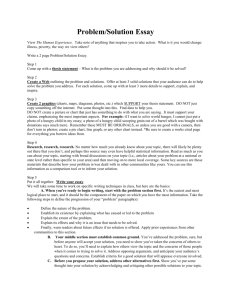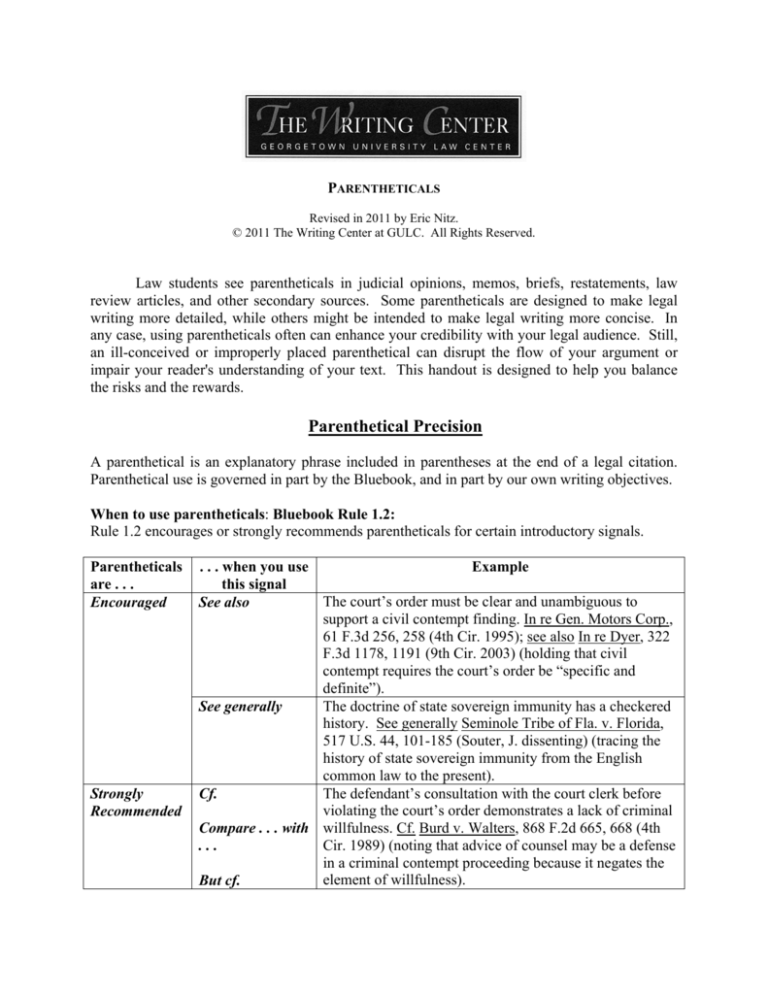
PARENTHETICALS
Revised in 2011 by Eric Nitz.
© 2011 The Writing Center at GULC. All Rights Reserved.
Law students see parentheticals in judicial opinions, memos, briefs, restatements, law
review articles, and other secondary sources. Some parentheticals are designed to make legal
writing more detailed, while others might be intended to make legal writing more concise. In
any case, using parentheticals often can enhance your credibility with your legal audience. Still,
an ill-conceived or improperly placed parenthetical can disrupt the flow of your argument or
impair your reader's understanding of your text. This handout is designed to help you balance
the risks and the rewards.
Parenthetical Precision
A parenthetical is an explanatory phrase included in parentheses at the end of a legal citation.
Parenthetical use is governed in part by the Bluebook, and in part by our own writing objectives.
When to use parentheticals: Bluebook Rule 1.2:
Rule 1.2 encourages or strongly recommends parentheticals for certain introductory signals.
Parentheticals
are . . .
Encouraged
Strongly
Recommended
. . . when you use
Example
this signal
The court’s order must be clear and unambiguous to
See also
support a civil contempt finding. In re Gen. Motors Corp.,
61 F.3d 256, 258 (4th Cir. 1995); see also In re Dyer, 322
F.3d 1178, 1191 (9th Cir. 2003) (holding that civil
contempt requires the court’s order be “specific and
definite”).
The doctrine of state sovereign immunity has a checkered
See generally
history. See generally Seminole Tribe of Fla. v. Florida,
517 U.S. 44, 101-185 (Souter, J. dissenting) (tracing the
history of state sovereign immunity from the English
common law to the present).
The defendant’s consultation with the court clerk before
Cf.
violating the court’s order demonstrates a lack of criminal
Compare . . . with willfulness. Cf. Burd v. Walters, 868 F.2d 665, 668 (4th
Cir. 1989) (noting that advice of counsel may be a defense
...
in a criminal contempt proceeding because it negates the
element of willfulness).
But cf.
The use of parentheticals is either encouraged or strongly recommended with these signals
because the relevance of the citation will often only make sense if it is explained. When you use
these signals, parentheticals will help your reader understand the application of your citation to
your argument.
Parentheticals in Practice: Bluebook Rule 1.5:
1. How to Phrase Parentheticals. Parenthetical explanations are generally phrases that begin
with a present participle, which is a verb that ends with “ing.” The present participle that begins
the parenthetical is not capitalized. If the meaning is clear from context, a short descriptive
parenthetical may be used rather than a phrase beginning with a present participle.
Example: See De Long v. Hennessey, 912 F.2d 1144, 1147 (9th Cir. 1990) (remanding
pre-filing injunction for failure to show that filings were numerous or abusive).
2. The Use of Quotations in Parentheticals. Parentheticals often include quotations from the
cited source, and in general the rule above concerning how to phrase parentheticals applies.
However, if the parenthetical explanation consists entirely of a quotation of one or more full
sentences (or part of a sentence that reads as a full sentence) then the following rules apply: the
first word of the parenthetical should be capitalized, and the parenthetical should include the
closing punctuation of the quoted sentence.
Example: United State v. Neal, 101 F.3d 993, 997 (4th. Cir. 1996) (“[I]ndirect contempt
may never be punished summarily, but rather requires adherence to more normal
adversary procedures.”).
3. Where Parentheticals Fit in the Citation Clause or Sentence. Explanatory parentheticals
come after parentheticals explaining weight of authority, such as (per curiam) or (Scalia, J.
dissenting), and before any citation of subsequent history or other related authority.
Example: Wolf v. Colorado, 338 U.S. 25, 47 (1949) (Rutledge, J. dissenting) (rejecting
the Court’s conception of the exclusionary rule), aff’g 187 P.2d 926 (Colo. 1947),
overruled by Mapp v. Ohio, 367 U.S. 643 (1961).
Thankfully, the Bluebook spells out the order in which different parentheticals should appear in
the citation:
(date) [hereinafter short name] (en banc) (Lastname, J., concurring) (plurality opinion) (per
curiam) (alternation in original) (emphasis added) (footnote omitted) (citations omitted)
(quoting another source) (internal quotation marks omitted) (citing another source), available
at http://www.domainname.com (explanatory parenthetical), prior or subsequent history.
2
When you have multiple parentheticals, simply consult the paragraph above and see which
parentheticals are applicable to your citation.
Parenthetical Possibilities
Here are some examples of when parentheticals are most appropriate:
Explaining related authority: Often you may cite to a source for a particular proposition and
wish to show that other sources also lend some support to this proposition. Depending on the
situation, you may introduce these additional sources with a see also or cf. signal.
Explaining the factual or legal context: A reader may benefit from this kind of added
“background,” particularly when an extended analysis of the case is not necessary or appropriate.
A parenthetical about the procedural posture or relevant facts of a case can help bolster your
argument and show your reader that you are using the case appropriately.
Example: Enjoining a litigant from filing is an extremely harsh sanction to be used only
in exigent circumstances. See De Long v. Hennessey, 912 F.2d 1144, 1147 (9th Cir.
1990) (remanding pre-filing injunction for failure to show that filings were numerous or
abusive).
Using a Group of Cases: Parentheticals are particularly useful when the proposition you are
putting forward is supported by a line of cases or is based on distinctions among a group of
cases. When you intend to highlight either the similarities or differences between a group of
cases, parentheticals can be a very efficient way to do this. Be careful that your use of
parentheticals does not take the place of a more extended comparison of cases when such a
comparison is warranted. Notice how the following example uses parentheticals that are short but
sufficiently detailed for the context in which they are used.
Example: Where a plea bargain or plea bargain-like agreement has been reached through
a fair negotiation, the Ninth Circuit may allow that agreement to be interpreted utilizing
contract law principles. See United States v. Chiu, 109 F.3d 624 (9th Cir. 1997) (proffer
agreements); United States v. Partida-Parra, 859 F.3d 629 (9th Cir. 1988) (plea
agreements); United States v. Irvine, 756 F.2d 708 (9th Cir. 1985) (cooperation-immunity
agreements); United States v. Carillo, 709 F.3d 624 (9th Cir. 1983) (cooperation
agreements).
Quoting language from a controlling authority: Extensive quoting in your main text may tend
to break up the flow of your argument. You may want to include quotations from the controlling
authority in parentheticals. Many readers appreciate that you have given them the words used by
the authority. Consider, however, that if the quotation is particularly important, it may be better
to include it in your main text, where it can be highlighted for the reader. Here is an example of
the effective use of quotations in a parenthetical.
3
Example: While direct contempt can be punished summarily by the judge,
indirect contempt can only be heard on notice and with procedural regularity.
United State v. Neal, 101 F.3d 993, 997 (4th. Cir. 1996) (“[I]ndirect contempt may never
be punished summarily, but rather requires adherence to more normal adversary
procedures.”).
Parenthetical Pitfalls
Before you decide to explain a case in a parenthetical, consider the following:
Pitfall #1: Parentheticals are a poor substitute for legal analysis. Parentheticals can provide
an efficient means of communicating basic information about a source. However, parentheticals
do not explain the relationship of the law to your set of facts as effectively as express legal
analysis and may even detract from your central point. Read the following passage to yourself:
Sample
The commonplace item that Fox saw, a keychain with the victim's etched initial,
lacks features of immediately apparent contraband such as drugs or weapons.
See D.C. Code Ann § 33-564 (2000) (allowing warrantless seizures of
controlled substances); United States v. Barckstrom, 252 A.2d 909, 910 (D.C.
1969) (noting that drugs and weapons are immediately apparent contraband).
Commonplace items, even with suspicious identification, receive less deference.
See Bynum, 386 A.2d at 687-88 (noting that tape recorder etched with name
and address that searching officer recognized from robbery report was not
immediately apparent contraband, in full probable cause analysis after holding
seizure illegal because officer lacked legal access); Gant v. United States, 518
A.2d 103, 109 (D.C. 1981) (holding that clothing that matched suspect's profile
"was not obvious" evidence). Similarly, the keychain lacks immediately
incriminating features . . . .
The writer refers to statutes and cases that seem to relate to her argument, but her use of
parentheticals prevents her from expressly connecting the law to the facts of her case. Now look
at the same argument after removing the parentheticals and weaving the law and facts together:
Parenthetical-free Sample
Fox’s warrantless seizure of the keychain with the victim's etched initial was
illegal. D.C. law permits the warrantless seizure of immediately apparent
contraband, such as controlled substances, see D.C. Code Ann. § 33-564 (2000),
and weapons, see United States v. Backstrom, 252 A.2d 909, 910 (D.C. 1969).
However, courts are far less likely to uphold the warrantless seizure of
commonplace items—even where those items bear suspicious identification.
For example, in Bynum, an officer seized a tape recorder etched with a name
and address that he recognized from a robbery report. The court declined to
find that the tape recorder was immediately apparent contraband sufficient to
support probable cause, and held that the seizure was illegal because the officer
lacked legal access to the goods. See Bynum, 386 A.2d at 687-88. Similarly, in
Gant v. United States, 518 A.2d 103, 109 (D.C. 1981), the court held that
4
clothing that matched the suspect’s “was not obvious” enough evidence to
generate probable cause to arrest. Just as the tape recorder in Bynum and the
clothing in Gant were commonplace items lacking immediately incriminating
features, so too is the keychain at issue in this case . . . .
By removing the parentheticals, the writer's analysis becomes clearer to the reader, and her
argument is more forceful.
Pitfall #2: Parentheticals can interrupt the flow of your argument. Now go back to the first
sample passage and read it aloud. Did you pause every time you encountered a parenthetical?
Was it difficult to keep track of how the argument was progressing? Parentheticals can disrupt
the momentum of your argument if inserted carelessly.
Pitfall #3: Parenthetical text might be ignored by the busy reader. When writing your
memo or brief, remember that your audience likely will be a busy attorney or judge. You can
use this to your advantage. Because you know ahead of time that your reader may be impatient,
why encourage her to skim—or even skip over—important pieces of your analysis? Try to
compel your reader to absorb every part of your argument. Placing information in a
parenthetical, rather than incorporating it into your main text, may send your reader a message
that “this information is not very important.”
Putting it all Together: Should I Use a Parenthetical?
Before drafting a parenthetical, ask yourself the following questions:
1. Know your audience.
• Does the lawyer, judge, or professor for whom you are writing have a preference
regarding the use of parentheticals? The more you know about their “parenthetical
preferences,” the better-equipped you will be to use a parenthetical to your advantage.
2. Which signal precedes the citation?
3. What role does the cited source play in my analysis?
• If the source is central to your main argument, you probably should discuss it in the main
text and avoid disposing of it in a parenthetical.
• If the source lends further support, but is not central to your analysis, a see also or cf.
citation, followed by a parenthetical might be appropriate.
• If your reader will not understand why you cited a source unless you identify that
source’s factual or legal context, you should either provide that context in a parenthetical
or discuss that source in your text.
• If you use the source to emphasize similarities to or distinctions from other cited sources,
a parenthetical might be appropriate.
4. Will using a parenthetical clarify or disrupt the flow of my document?
5
•
Thanks to word processing technology, it’s pretty easy to have your parenthetical-laden
text and a parenthetical-free version side by side. Spend a few minutes absorbing this
contrast. Do some clarify more than others? Are some more disruptive than others?
6

